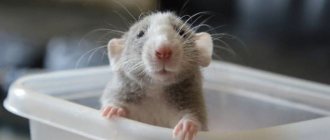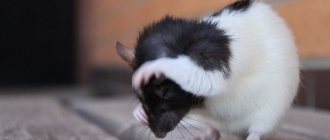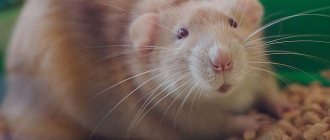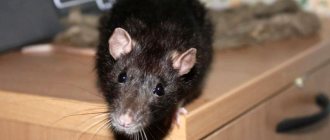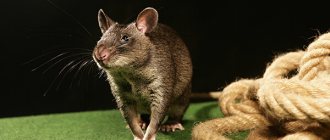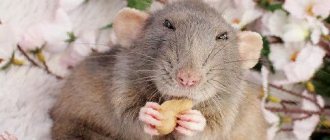Unfortunately, the lifespan of a decorative rat is only 2-3 years. During this time, owners become strongly attached to their pets and learn all their habits and habits. Therefore, parting is always difficult and painful, both for adults and children.
Let's find out what signs indicate the approaching death of a pet so that we can prepare in advance and decide what to do with the body.
Rat injuries
Rodent owners have often heard about the “survivability” of their pets.
Many people are sure that if a rat falls from a height, then the likelihood of getting a bruise or injury is minimal. In fact, animals require constant supervision and care, since even the slightest damage to the skin can cause infection and disease. Most often, rodents injure their tails and paws. Natural curiosity and activity provoke fractures in rats and violations of the integrity of the skin. Unfortunately, even under constant human supervision, an animal can get injured. If the rodent is skinned or injured, the owner should provide first aid to the pet and visit a veterinarian as soon as possible.
Prevention
Breathing problems in a decorative rat can lead to serious complications, including the death of the animal. Therefore, it is better to take care of your pet’s health in advance and prevent the development of pathologies of the respiratory system. Preventive measures include:
- Proper nutrition . A balanced diet will strengthen the furry's immune system, prevent excess weight gain and the deposition of cholesterol plaques in the blood vessels. In addition to ready-made food, the pet’s menu must include fresh fruits, berries, vegetables, dairy products, lean meat, nuts, fish, and seafood. At the same time, it will be necessary to exclude sweet, salty, fried, spicy, smoked foods and baked goods from the rat’s diet.
- Maintaining hygienic conditions . To avoid the development of infectious diseases, you will need to always keep your pet's cage clean - clean it every week. And once a month - completely disinfect the cage and its contents. The filler needs to be changed as needed. But no less than once every 2-3 days.
- Protecting your fluffy from colds . Rats are very sensitive to changes in environmental conditions; they can get sick from the slightest breeze. Particular attention should be paid to drying the animal's fur after bathing.
- Protecting your pet from nervous tension . Clashes with other pets, noisy parties, long travels - all of the above can become a huge stress for a rat. And many diseases, especially oncology, develop against the background of an unstable psycho-emotional state.
- Eliminating potential allergens from a rodent's life . For rats, these can be grapes, citrus fruits, dried apricots, sausages, yogurt, strawberries, and pine filler.
If the rat is breathing heavily, choking, wheezing, grunting, or opening its mouth, do not immediately panic. It is necessary to find out the causes as early as possible and select appropriate treatment. Naturally, with the help of a veterinarian. Under the supervision of a specialist, it will be possible to restore your pet’s well-being quickly and without problems.
Bone tissue injuries
The most common injury is a broken tail in a rat, which occurs as a result of being pinched by a cage door. It is not uncommon for owners or family members to unintentionally step on a rodent.
Veterinarians are confident that if a rat breaks its tail and is examined by a specialist in time, breeders can rest assured. Typically, the broken part must be amputated, but in rare cases the animal may chew it off. If a wound is found on the tail, the area is treated with a weak solution of potassium permanganate.
If the owner accidentally steps on a rat and the animal is injured, it is important to act quickly:
- place the animal on a flat surface;
- if a rodent has broken its spine, it will drag its hind legs;
- when an animal drags one paw, then we are talking about a fracture of the limb.
The exact type of damage is only visible on x-rays. If a spinal fracture is suspected in a rat, the rodent is placed in a small box and covered with cotton wool. If an animal has a broken leg, it is permissible to apply a splint made from a flat stick above the fracture site.
After initial measures, it is necessary to take an x-ray of the rat’s paw fracture so that the doctor can make an accurate diagnosis.
Other causes of difficulty breathing
In addition to the listed main causes of heavy breathing with whistling, coughing and grunting, the following pathological conditions can lead to the appearance of similar symptoms:
- Low humidity in a room with a cage . The optimal figure is considered to be 50-60%. At lower values, the animal’s mucous membranes dry out and a lot of mucus forms in the nasal passages. The result is difficulty breathing with a characteristic gurgling sound.
- Deviation of the nasal septum . Such anatomical features are characteristic not only of humans, but also of animals. In this case, there is no way to get rid of noisy breathing. The main thing is to take the rat to a veterinary clinic and make sure that the problem is the curvature.
- If the condition deteriorates sharply, the animal suffocates and struggles in a fit, most likely the pet simply choked . In such a situation, you need to take the fluffy in your hands, fix the head (so that the neck does not dangle) and trot intensively. The stuck piece of food should pop out.
- ARVI . An animal with a cold usually coughs and sneezes intensely and breathes heavily. A rat can catch ARVI from a banal draft or hypothermia. Antibiotics and mucolytic drugs will help your pet against colds.
- Allergic reactions . When an animal has an allergy, it’s not just breathing problems that arise. Fluffy begins to itch intensely, the eyelids swell, and a small rash appears on the skin. Most often, rats are allergic to low-quality litter or food (citrus, red pepper, sweets). Therefore, to alleviate the animal’s condition, the first step is to eliminate the allergen. After which - give a couple of drops of an antihistamine - Fenistil, Dezal, Zodak.
Sometimes allergic reactions can develop into life-threatening conditions for the animal - Quincke's edema and anaphylactic shock. At the same time, the pet begins to fall, suffocate, greedily swallowing air through its mouth. As an emergency, you will need to inject your fluffy with Prednisolone in combination with Suprastin.
Skin injuries
While playing or walking around the house, it is important for owners to keep an eye on their pet to protect it from fractures and soft tissue injuries. Remember that rodent skin is very sensitive and can be damaged by awkward movements.
If a rat has skinned its tail, treat the surface with a disinfectant and visit a doctor. In some cases, the area needs to be amputated, but with proper and timely treatment, the tissue is restored.
When several animals are in the same cage, it is important for owners to monitor the behavior of their pets so that during play they do not tear off the skin or cause injury to each other. During sleep, the animal may fall, so you should ensure that there are no thorny or dangerous objects.
Active animals often receive burns and scratches on their tails and paws. If there is an open wound, it must be treated. If the area of skin that is scraped or damaged is significant, the wood litter should be replaced with a cloth to prevent infection.
Preventive measures
It is advisable to engage in extermination of rats before repairs . This can be done in a variety of ways:
- Glue-based traps with bait in the middle: they are installed not far from the hole, so that later they, along with the stuck victim, can be easily removed;
- Mechanical rat traps: installed along the route of the rodent;
- Repellent odors;
- Ultrasonic rat repellers.
One of the popular fishing methods is Victor electric rat traps with ready-made baits. In appearance, the trap is a two-story container: the rat runs into it, goes to the second floor with the bait, is subjected to a strong electrical discharge and, killed, falls into a special compartment on the first floor.
Repelling mice and rats using ultrasound (for example, the Tornado-200 or Tornado-300 device) is one of the most promising methods of deratization.
It is worth remembering that the ultrasonic signal of the trap does not pass through hard surfaces, in addition, the pile of carpets can hide its effect.
At the same time, in order not to resort to using the device every time the rats return to the home, it is necessary to worsen their living conditions as much as possible: install protective metal mesh, seal the holes.
Tips and tricks for injuries
Even the most responsible and attentive owner is sometimes unable to keep track of the animal. If a rat has torn off its skin or your pet has fallen from a height, you should remember simple rules:
- Examine your pet carefully. If the skin is severely damaged or the animal has difficulty moving, you should immediately consult a doctor.
- Find out whether the animal could have been accidentally stepped on to rule out injuries to the spine and limbs.
- Do not forget that minor tissue damage is only visible on an x-ray.
If a rat breaks its leg after falling from a great height, carefully restrain the animal and apply a splint to prevent displacement. In case of fractures, it is important to ensure complete rest and limit movement as much as possible.
When an animal's limbs are broken, the recovery process largely depends on the prompt actions of the doctor and breeder. After being examined by a veterinarian and prescribing treatment procedures, strictly follow the recommendations and make sure that the rodent does not fall again or damage the skin.
How long do decorative rats live and why you shouldn’t trust rodent sellers
Sometimes you can hear from experienced breeders of decorative rats that these animals, with proper care, can easily cross the seven-year age limit. Unfortunately, the reality is not so rosy, since rats are susceptible to many pathologies that have a negative impact on their health and thereby significantly reduce their life expectancy.
Decorative rats live from 2 to 3 years
Consultants in pet stores recommend decorative rats as extremely hardy and unpretentious animals. In fact, this statement is from the evil one. Veterinary science says that rats, like other pets, can have a variety of health problems. In addition, without timely help, some pathologies can kill the animal.
Decorative rats get sick very often
Symptoms
In most cases, there is an increase in body temperature and pressure.
The pet limps on the affected limb, it swells, twists in an unnatural way, and drags when moving.
A closed fracture is accompanied by a hematoma, an open fracture is accompanied by a wound with bleeding.
If the bones of the chest are damaged, breathing becomes difficult; if the spine is injured, the pet cannot move, stops responding to external stimuli, and lies with its eyes closed.
Treatment
The first stage is restriction of mobility. To do this, the animal is not allowed to go for a walk, but is transplanted into a deep container or plastic basin.
If this is not possible, ladders and tunnels should be removed from the cage, and the bedding should be replaced with paper napkins to prevent the rodent from rummaging.
The owner's peace and attention will help the pet recover faster.
The second stage is ensuring a nutritious diet. In the case of hamsters whose front paw is affected, it is important to prevent the cheek pouches from becoming stuffed.
The animal will not be able to remove food from there, which will cause inflammation.
Closed fractures do not cause the death of the animal, but if the bones heal incorrectly, lameness will remain.
The situation is much more serious with open ones, since the bone can damage both muscles and skin. As a result, an extensive injury is formed and blood flows.
To prevent infection, you must:
- use painkillers for 1-3 days to prevent pain shock,
- treat it several times a day with miramistine or chlorhexidine using a syringe without a needle,
- for purulent inflammation, apply Syntomycin emulsion and Levomekol,
- if the paw is festered, use injections of antibiotics - enroxil or baytril,
- maintain cleanliness and order, remove feces in a timely manner, change sawdust from bedding to napkins, give food in small portions so that the animal does not stock up.
Under no circumstances should you:
- include dairy and other calcium-rich foods in your diet - this will interfere with fusion,
- Applying plaster will not bring the desired results, but will only cause harm.
In difficult situations, amputation is resorted to. The operation is performed under general anesthesia, leaving a neat stump.
Moreover, the animal can live quite comfortably with three legs. This measure will avoid necrosis and blood poisoning.
Call a veterinarian ratologist to your home around the clock
The staff of the VetDrug clinic offers qualified assistance not only in the veterinary center, but also at home.
You can call a doctor 24 hours a day in Moscow and the Moscow region and receive:
- timely and high-quality professional assistance for any disease,
- favorable prices and the ability to pay not only in cash, but also through the Sberbank Online service,
- the ability to choose the right moment for a specialist’s visit, for example, in the evening after work or on a day off,
- maximum comfort and attention for your pet, who will remain at home and will not have to be taken to the hospital.
Source
What types of tumors are there?
A tumor is a pathology in which the growth of qualitatively changed tissues in the body occurs. They cease to differentiate, but do not lose the ability to constantly divide. True tumors grow by dividing their own cells. Although experts have been studying the issue of combating cancer for many decades, mortality from this disease continues to increase every year. Unfortunately, this pathology has not escaped animals either. Tumors are especially common in rats, ranking second among the causes of their mortality (after infectious diseases).
Important! It is worth noting that tumors in one-year-old animals are noted only in 6% of cases, but closer to the age of two years this figure increases to 20%.
There are two main types of neoplasms:
- benign - separated from other cells by a membrane and easily removed surgically without subsequent metastases;
- malignant - can grow and swell, affecting tissues that are in close proximity, often giving metastases and relapses after surgery.
Experts note that females have the greatest predisposition to the occurrence of tumors, while among males the incidence rate is much lower. The issue of the occurrence of neoplasms also depends on the lifestyle of the rodent, its emotional state (stress, depression), as well as previous injuries. In some cases, the tumor doubles in size in just a few days.
Learn how to properly bathe a rat at home.
The rat is dying! Spinning, eyes rolling!
It started 1 day ago when she fell from a height of half a meter and injured her paws. After that, for 1 day she limped and behaved violently, at the end of the day she began dragging these paws and could not sit still. I anointed her paw with Voltareno emulgel and rubbed it dry, because... there was nothing suitable in the house. And by the end of the day he gave homovit. Homovite is not expired, but the color is no longer so red. Half an hour after taking it, it became even more violent. When I pulled her out of the cage and decided to check her paws, it turned out that her back paw was possibly broken and displaced, although I am not a traumatologist, I could be wrong. And after another 5 minutes she began to spin around and roll her eyes. It was useless to stop her. I peed and pooped in addition. Then she stopped for a moment and stopped breathing. She performed artificial respiration and continued spinning. They forcibly blocked her movements, picked her up and stroked her for several minutes. If you put it on a flat surface and hold it, it can lie quietly for about 5 minutes in a crouched and tense position, and then it will dig in again convulsively. cannot hold his head straight at all, twists to the right. parphyrite stands out. I wanted to relieve pain - I injected 0.05 ml of ketanol - zero effect. We’ve been sitting like this in agony for 4 hours. Once I managed to pick her up so that she stopped twisting and rolling her eyes, but she didn’t sit there for long.
Huge request for help! We'll wait until the morning and go to the clinic! There are no 24-hour ones. But our doctors are terrible. We once turned to them with a tumor, and they said that it was just a boy and his testicles had not fallen out. A week later, the tumor was cut and the pus was removed. And again we had a girl in our arms. So, although I will bear it, I can’t trust them! Could it be voltaren poisoning if it was licked off somewhere? or from homovit that has lost its color?
UPD: I just noticed that if you turn your head in the opposite direction [opposite from the way it turns it itself while twisting... and it always turns only in one direction], then the rat feels better while its head is in this position. If you hold it in this position for a long time, then when I let go, for the first 5 seconds she can move normally, then she immediately twists her and she begins to spin, squirming and rolling her eyes. I also noticed some lumps on my neck, like inflamed lymph nodes. Could there be pinched nerves?
Our advantages
A rat fell from a height in Rostov-on-Don - we have the solution.
That's why they choose us to bake.
Pet taxi
We will help your friend at home, or transport him to the clinic, using our own zoo-taxi
Seven days a week
Our only day off is January 1st. You can contact us any day, we work around the clock, without days off or breaks.
New technologies
The clinic’s equipment makes it possible to perform operations that are inaccessible to other veterinary hospitals in the city.
Good plus
You can purchase medicines and food for your animal directly from our clinic.
Let's be professional
Our doctors are professionals with extensive experience and a responsible approach to their work.
Let's improve
We are members of the Union of Pet Business Enterprises of Russia, initiators of programs for the development of progressive veterinary medicine and animal care.
Need advice about a rat
| HTML code: |
| BB code for forums: |
How will it look like?
| Good afternoon rodent lovers! Today our rat Nano fell from a height of about 0.5 m onto a cage with a guinea pig. At the same time, she squeaked loudly when I began to remove her from there; one of her hind legs, the sole itself with her toes, seemed to be off to the side. The rat itself was very frightened and began to climb on me, but I held it, began to stroke it and calm it down, while it lay quietly. Read completely |



